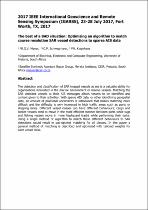 ResearchSpace
ResearchSpace
The best of a BAD situation: Optimising an algorithm to match course resolution SAR vessel detections to sparse AIS data
JavaScript is disabled for your browser. Some features of this site may not work without it.
- ResearchSpace
- →
- Research Publications/Outputs
- →
- Conference Publications
- →
- View Item
| dc.contributor.author |
Meyer, Rory GV

|
|
| dc.contributor.author |
Schwegmann, Colin P

|
|
| dc.contributor.author |
Kleynhans, Waldo

|
|
| dc.date.accessioned | 2018-04-06T10:39:14Z | |
| dc.date.available | 2018-04-06T10:39:14Z | |
| dc.date.issued | 2017-07 | |
| dc.identifier.citation | Meyer, R.G.V., Schwegmann, C.P. and Kleynhans, W. 2017. The best of a BAD situation: Optimising an algorithm to match course resolution SAR vessel detections to sparse AIS data. In: 2017 IEEE International Geoscience and Remote Sensing Symposium (IGARSS), 23-28 July 2017, Fort Worth, Texas, USA | en_US |
| dc.identifier.isbn | 978-1-5090-4950-9 | |
| dc.identifier.issn | 2153-7003 | |
| dc.identifier.uri | http://ieeexplore.ieee.org/document/8127471/ | |
| dc.identifier.uri | http://hdl.handle.net/10204/10168 | |
| dc.description | 2017 IEEE International Geoscience and Remote Sensing Symposium (IGARSS), 23-28 July 2017, Fort Worth, TX, 2017 | en_US |
| dc.description.abstract | The detection and classification of SAR imaged vessels at sea is a valuable ability for organisations interested in the marine environment or marine vessels. Matching the SAR detected vessels to their AIS messages allows vessels to be identified and context given to their activities. With sparse AIS data, or other identifying geospatial data, an amount of positional uncertainty is introduced that makes matching more difficult and the difficulty is only increased in high traffic areas such as ports or shipping lanes. Different vessel classes can have different behaviours; cargo and tanker vessels tend to move in the most efficient manner between ports while tugs and fishing vessels move in more haphazard tracks while performing their tasks. Using a single method or algorithm to match these different behaviours to SAR detections would result in sub-optimal matching for all classes. In this paper a general method of matching is described and optimised with tailored weights for each vessel class. | en_US |
| dc.language.iso | en | en_US |
| dc.publisher | IEEE | en_US |
| dc.relation.ispartofseries | Workflow;20108 | |
| dc.subject | SAR imaged vessels | en_US |
| dc.subject | SAR detections | en_US |
| dc.subject | Automated Identification System data | en_US |
| dc.subject | AIS data | en_US |
| dc.subject | Geospatial matching | en_US |
| dc.title | The best of a BAD situation: Optimising an algorithm to match course resolution SAR vessel detections to sparse AIS data | en_US |
| dc.type | Conference Presentation | en_US |
| dc.identifier.apacitation | Meyer, R. G., Schwegmann, C. P., & Kleynhans, W. (2017). The best of a BAD situation: Optimising an algorithm to match course resolution SAR vessel detections to sparse AIS data. IEEE. http://hdl.handle.net/10204/10168 | en_ZA |
| dc.identifier.chicagocitation | Meyer, Rory GV, Colin P Schwegmann, and Waldo Kleynhans. "The best of a BAD situation: Optimising an algorithm to match course resolution SAR vessel detections to sparse AIS data." (2017): http://hdl.handle.net/10204/10168 | en_ZA |
| dc.identifier.vancouvercitation | Meyer RG, Schwegmann CP, Kleynhans W, The best of a BAD situation: Optimising an algorithm to match course resolution SAR vessel detections to sparse AIS data; IEEE; 2017. http://hdl.handle.net/10204/10168 . | en_ZA |
| dc.identifier.ris | TY - Conference Presentation AU - Meyer, Rory GV AU - Schwegmann, Colin P AU - Kleynhans, Waldo AB - The detection and classification of SAR imaged vessels at sea is a valuable ability for organisations interested in the marine environment or marine vessels. Matching the SAR detected vessels to their AIS messages allows vessels to be identified and context given to their activities. With sparse AIS data, or other identifying geospatial data, an amount of positional uncertainty is introduced that makes matching more difficult and the difficulty is only increased in high traffic areas such as ports or shipping lanes. Different vessel classes can have different behaviours; cargo and tanker vessels tend to move in the most efficient manner between ports while tugs and fishing vessels move in more haphazard tracks while performing their tasks. Using a single method or algorithm to match these different behaviours to SAR detections would result in sub-optimal matching for all classes. In this paper a general method of matching is described and optimised with tailored weights for each vessel class. DA - 2017-07 DB - ResearchSpace DP - CSIR KW - SAR imaged vessels KW - SAR detections KW - Automated Identification System data KW - AIS data KW - Geospatial matching LK - https://researchspace.csir.co.za PY - 2017 SM - 978-1-5090-4950-9 SM - 2153-7003 T1 - The best of a BAD situation: Optimising an algorithm to match course resolution SAR vessel detections to sparse AIS data TI - The best of a BAD situation: Optimising an algorithm to match course resolution SAR vessel detections to sparse AIS data UR - http://hdl.handle.net/10204/10168 ER - | en_ZA |





